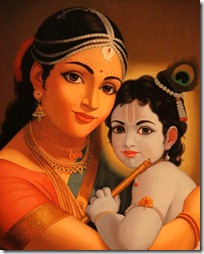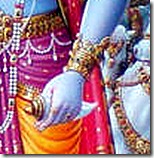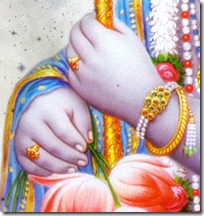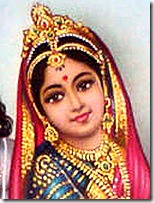 “Yogis cannot capture Krishna by severe penances and austerities, but mother Yashoda, despite all obstacles, was finally able to catch Krishna without difficulty. This is the difference between a yogi and a bhakta.” (Shrila Prabhupada, Shrimad Bhagavatam, 10.9.10) “Yogis cannot capture Krishna by severe penances and austerities, but mother Yashoda, despite all obstacles, was finally able to catch Krishna without difficulty. This is the difference between a yogi and a bhakta.” (Shrila Prabhupada, Shrimad Bhagavatam, 10.9.10)
Mother Yashoda had everything going against her in her chase for her young son. Being very clever, the young boy could run away at the first sign of trouble. He was quick as well, as He had just speedily left the scene of a minor crime, one which He had perpetrated. On the other side, the beautiful mother was nicely dressed, not wearing clothes conducive to running. As a mature woman, she was weighed down by the upper portion of her body, which hampered her ability to run. The person she was running after also happened to be the most elusive person in the world, who can only be caught by one method. Mother Yashoda unknowingly knew what that method was, and she was therefore able to catch her son.
 Why is this person so elusive? And what is the one method that can be used to catch Him? The Vedas describe the young son of Yashoda by the word Krishna, which means all-attractive. Attraction is what grabs the attention of others; captivating them, reeling their interest in. An attractive painting is nice to look at, for the famous saying is, “A picture is worth a thousand words.” This means that you can look at one picture day after day and find new ways to describe it. Not that the previous descriptions were incorrect or insufficient, but the scene depicted can be so beautiful and have so much context that many new explanations spring forth upon each glance. Why is this person so elusive? And what is the one method that can be used to catch Him? The Vedas describe the young son of Yashoda by the word Krishna, which means all-attractive. Attraction is what grabs the attention of others; captivating them, reeling their interest in. An attractive painting is nice to look at, for the famous saying is, “A picture is worth a thousand words.” This means that you can look at one picture day after day and find new ways to describe it. Not that the previous descriptions were incorrect or insufficient, but the scene depicted can be so beautiful and have so much context that many new explanations spring forth upon each glance.
Those who know the Supreme Personality of Godhead, the all-attractive Krishna, have a similar experience when trying to describe His glories. While the painting has a measurable context in the background which can be discussed, Shri Krishna is all-inclusive. Every aspect of this creation can be tied to Him, provided that one can use the torchlight of knowledge passed down by the Vedic seers. Though the spirit soul, the essence of identity, is supremely knowledgeable, when entrapped in a covering of nescience, there is no way to find that internal light without using the tools handed down by others.
Does this mean that we can go on studying and studying and never uncover the brilliant knowledge that already belongs to us? Through connecting with Krishna - who is the same in quality as the spirit souls except for the fact that His brilliant features never get covered - one can find the knowledgebase that already belongs to them. With the divine connection comes dexterity in thought, the ability to know every aspect of the creation’s link to Shri Krishna. A person who knows Krishna can look at the grass on the ground and find some way to remember Krishna. They can take a sip of water and have the taste remind them of the Lord, a practice directly hinted at by Shri Krishna in the Bhagavad-gita.
 Connecting with Krishna occurs through the methods of bhakti-yoga, or devotional service Connecting with Krishna occurs through the methods of bhakti-yoga, or devotional service
We often hear that it is good to worship God in order to put the many obligations in your life into the proper perspective. How to actually go about worshiping is where the paths diverge. Through the holy name one can directly connect with the Lord in all His glory. Chanting
the holy name with love is the topmost activity in spirituality, superior to any type of sacrifice, penance, austerity, visit to a pilgrimage site, or meditation.
In other methods of spiritual practice, the ultimate objective, whether known or not, is to reach the point where the holy name is cherished, honored and regularly recited. The example of Mother Yashoda chasing after Krishna is a case in point. Every person is attracted by Krishna and is thus trying to catch Him, but depending on the aspect they choose to associate with, their effort may not be successful. Think of it as looking at the same beautiful painting but with your vision impaired. The atheist, he who is completely in the dark about the changing nature of the body and how spirit is transcendental to matter, has no clue what the picture really looks like. They have no choice but to speculate, formulating theories that can never be tested for validity. Any competing theory is just as good, for no one can validly assert correctness when there is no light.
Even when operating in the dark one is connecting with Krishna in some way, for the material energy comes from Him. The problem is that Krishna Himself is not personally present in the all-pervading impersonal aspect. He is the support of every life form but this doesn’t mean that every life form is God. Just as we can’t communicate with someone by talking to their feet, we can’t directly connect with Krishna by worshiping matter and harboring attachment for it. There are authorized methods of linking with the divine consciousness, and without following these methods there is no chance of catching Krishna.
 Those who are somewhat knowledgeable about spirituality can shine some more light on the portrait ofShyamasundara Those who are somewhat knowledgeable about spirituality can shine some more light on the portrait ofShyamasundara
The meditational yogi realizes God’s presence locally within the heart as the Paramatma. The yogi is far superior to the materialist, for they explicitly try to capture God within. Yet even after much time in meditation there is still no guarantee of success. In yoga there is no loss from expending effort, for Shri Krishna in the Bhagavad-gita alleviates the fears of those worried over a wasted attempt by telling Arjuna that the unsuccessful yogi takes birth in auspicious circumstances in the next life and gets to resume their yoga from the point at which they left off.
The bhakta, however, captures Krishna completely, even without qualifying themselves through deep study or intense meditation. In the Vedic tradition women are generally considered unintelligent with respect to understanding the high truths of Vedanta, or the ultimate system of knowledge. While to say someone is unintelligent is considered an insult, in bhakti this apparent defect can be very helpful. Basic intelligence is only useful if the proper end is desired. For instance, someone can be very well equipped to do physics and mathematics, but if they use their talents for creating bombs and other items that cause mass destruction, how is their intelligence beneficial to anyone?
 Mother Yashoda wasn’t a Vedantist, nor was she a yogi. She did not spend any time sitting in asanas or fixing her eyes on the tip of the nose and meditating on the sacred syllable om. Rather, she was just an ordinary cowherd woman and mother who loved her son very much. Because of her love for her beloved Krishna, who is the Supreme Lord and object of worship for the yogis and jnanis, she was able to capture Him. The Lord even tried to escape from her a few times to enhance the loving exchanges, but He was not able to get away. Yashoda’s net of love was too far reaching for the young Krishna to break free from. Mother Yashoda wasn’t a Vedantist, nor was she a yogi. She did not spend any time sitting in asanas or fixing her eyes on the tip of the nose and meditating on the sacred syllable om. Rather, she was just an ordinary cowherd woman and mother who loved her son very much. Because of her love for her beloved Krishna, who is the Supreme Lord and object of worship for the yogis and jnanis, she was able to capture Him. The Lord even tried to escape from her a few times to enhance the loving exchanges, but He was not able to get away. Yashoda’s net of love was too far reaching for the young Krishna to break free from.
Studying Vedanta philosophy, doing meditational yoga, following strict austerities, and performing sacrifices and rituals are indeed beneficial, for they bring one closer towards realizing and loving Krishna. There is a sacrifice known as the Satyanarayana Puja performed monthly by many followers of the Vedic tradition. This puja yields auspiciousness both in the current life and the next. Part of the worship involves reciting stories relating to Shri Satyanarayana, and at the end of the storytelling it is revealed that Sudama Vipra and Maharaja Dasharatha were some of the famous personalities of the past who performed the puja. By following the sacrifice regularly, in theirnext births they were able to associate directly with the Supreme Personality of Godhead and offer their pure love to Him. Dasharatha got to have Krishna appear as His son named Rama. Sudama Vipra got to worship Krishna directly in a mood of friendship.
In this way it can be understood that one who takes to bhakti has already performed many pious acts in past lives. The pious behavior indirectly led them to Krishna’s company, but only through the loving attitude were they actually able to catch up to the Lord. In Mother Yashoda’s case, her young son had broken a pot of butter in anger and then ran off with the goods. Seeing what He had done, the sweetheart lady affectionately chased after her child with a whipping stick. Krishna ran away, pretending to be afraid, and though the odds were in His favor, He was nevertheless caught.
 Hearing about this story is as good as having been there. Though the mind is chanchala, or restless, try to fix it on the holy name of the Lord and discussions of His pastimes. The cowherd mother would capture Krishna in her heart even when He wasn’t by her side. Yashoda would turn His childhood activities into songs and sing them while tending to household chores. One can perform meditational yoga which is very difficult to follow, especially in this age, and maybe hope to one day catch Krishna, after so much time and effort is spent, or one can just chant the Lord’s names, remember His activities, and go on with their routine work. The latter option is not only easier but it is more effective, as proved by the queen of Vraja herself. She is still honored and worshiped to this day, for the heart delights in remembering her fondness for her darling son. Hearing about this story is as good as having been there. Though the mind is chanchala, or restless, try to fix it on the holy name of the Lord and discussions of His pastimes. The cowherd mother would capture Krishna in her heart even when He wasn’t by her side. Yashoda would turn His childhood activities into songs and sing them while tending to household chores. One can perform meditational yoga which is very difficult to follow, especially in this age, and maybe hope to one day catch Krishna, after so much time and effort is spent, or one can just chant the Lord’s names, remember His activities, and go on with their routine work. The latter option is not only easier but it is more effective, as proved by the queen of Vraja herself. She is still honored and worshiped to this day, for the heart delights in remembering her fondness for her darling son.
In Closing:
Yashoda’s son of Vraja is darling,
His face precious, and smile so charming.
When He runs away He has the upper hand,
On mother who carries a stick in her hand.
Against Krishna no force is a fair match,
Yet Yashoda her son able to catch.
Thus to jnani and yogi she is superior,
Had no interest in energy that is inferior.
Story of mother’s love for son still told,
Hear it with ears and in mind watch it unfold.
|
Search This Blog
Friday, December 30, 2011
Catch Me If You Can
Subscribe to:
Post Comments (Atom)
No comments:
Post a Comment